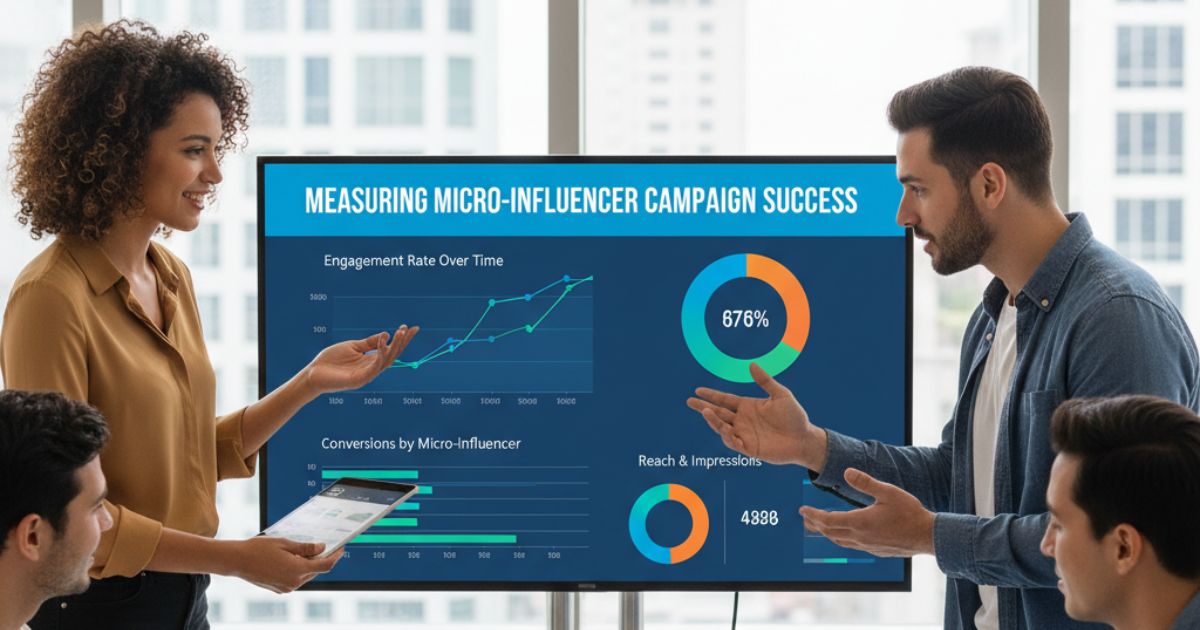People trust recommendations from real people more than traditional ads. They want honest opinions and personal experiences they can relate to. This is where micro-influencers make a difference. Unlike celebrities with millions of followers, micro-influencers have smaller, more tightly knit communities. Their followers engage deeply, making their endorsements feel authentic and trustworthy.
Micro-influencers are especially effective for word-of-mouth (WOM) marketing. When they share a product or service, it feels like a genuine recommendation from a friend rather than a sales pitch. This authenticity can increase brand awareness, drive engagement, and even boost sales—all without the high costs of celebrity campaigns.
Stay with us, you’ll discover how to use micro-influencers to grow your brand, reach the right audience, and create meaningful connections. We’ll cover who micro-influencers are, the benefits they bring, strategies to collaborate with them, and tips to measure the success of your campaigns.
What Are Micro-Influencers?
Micro-influencers are social media creators with 5,000 to 50,000 followers. They focus on specific niches such as fitness, beauty, tech, or lifestyle. Their strength is not the size of their audience but the quality of engagement.
Followers trust micro-influencers because they feel personal connections. Recommendations from them seem natural and genuine, not like traditional advertisements. Brands can use this trust to increase awareness, drive sales, and improve customer loyalty.
Why Micro-Influencers Are Important in WOM Marketing
Word-of-mouth marketing is most effective when recommendations feel personal. Micro-influencers help brands achieve this because:
-
Higher Engagement: They often get 2–4 times higher likes, comments, and shares compared to larger influencers.
-
Authenticity: Their followers perceive them as genuine individuals, not paid endorsers.
-
Cost-Effective: Working with micro-influencers is budget-friendly but delivers strong ROI.
-
Targeted Reach: They focus on niche audiences, making campaigns more precise.
Using micro-influencers is a smart way to make your brand message feel authentic, which is key for viral word-of-mouth growth.
How to Identify the Right Micro-Influencers

Finding the right influencer is essential. Here are the main criteria:
1. Audience Alignment
Check if the influencer’s followers match your target market. Consider demographics, interests, and purchasing behaviours. This ensures your message reaches potential customers who care.
2. Engagement Metrics
Don’t just look at follower numbers. Evaluate likes, comments, story views, and shares. High engagement indicates that the audience is genuinely interacting.
3. Authenticity
Review their past collaborations. Do promotions feel natural or forced? Authentic content drives trust and encourages more shares and conversations.
4. Content Quality
Good visuals, captions, and storytelling matter. Influencers with quality content create a more substantial impact on their audience.
Strategies to Leverage Micro-Influencers
Once you choose the right influencers, you need a clear plan. Here are effective strategies:
1. Co-Created Content
Invite influencers to collaborate on creating content, such as videos, blogs, or live streams. Let them present your brand in their style. This improves authenticity and shareability.
2. Exclusive Offers and Early Access
Give micro-influencers special products or early previews. Their followers feel special, which increases engagement and excitement.
3. Community Events and Meetups
Host webinars, virtual panels, or local gatherings with influencers. Face-to-face interactions strengthen relationships and generate real testimonials.
4. User-Generated Content Campaigns
Encourage influencers and followers to share branded hashtags, photos, or videos. Feature the best content on your brand channels to boost reach.
5. Referral and Discount Campaigns
Offer promo codes or referral links for influencers to share. This directly drives traffic, sales, and measurable ROI.
Measuring the Success of Micro-Influencer Campaigns

Tracking results is crucial. Key metrics include:
-
Engagement Rate: Likes, comments, shares, and story interactions.
-
Referral Traffic: Website visits and landing page conversions from influencer links.
-
Sales Lift: Revenue growth from influencer campaigns.
-
Brand Sentiment: Social listening to track brand mentions and audience perception.
Tools like Google Analytics, social media dashboards, and UTM tracking help measure performance accurately.
Best Practices and Common Mistakes to Avoid
To make your campaigns successful:
-
Build Genuine Relationships: Treat influencers as long-term partners, not one-time vendors.
-
Set Clear Guidelines: Provide clear instructions while allowing for creative freedom to produce authentic content.
-
Avoid Over-Saturation: Don’t engage too many influencers in the same niche simultaneously.
-
Stay Transparent: Always disclose sponsored content to comply with FTC rules.
-
Focus on Quality Over Quantity: One highly engaged influencer is better than many inactive ones.
Avoiding these mistakes ensures your campaigns remain credible and compelling.
Conclusion: Take Your WOM Marketing to the Next Level
Micro-influencers provide an affordable and authentic way to boost word-of-mouth marketing. By selecting the right partners, co-creating engaging content, and carefully tracking results, brands can reach new audiences and drive growth.
Start small. Test collaborations with a few influencers. Learn from each campaign and scale your efforts gradually. The key is consistency, authenticity, and understanding your audience.
Next Step: Identify three micro-influencers in your niche today. Reach out with a collaboration proposal and watch your brand buzz spread organically online.
By leveraging the power of micro-influencers, you can establish authentic connections, broaden your reach, and achieve rapid growth in your marketing campaigns.
FAQs
How do micro-influencers build trust with their followers?
Micro-influencers engage directly with their audience through comments, DMs, and personalized content. Their smaller, tight-knit communities make their recommendations feel genuine and relatable.
Can multiple micro-influencers be used in a single campaign?
Yes, but it’s best to choose influencers in complementary niches. Too many in the same niche can dilute your message and reduce impact.
What platforms are best for micro-influencer marketing?
Instagram, TikTok, YouTube, and LinkedIn are popular platforms. The choice depends on your target audience and where your niche community is most active.
Should micro-influencers always disclose sponsorships?
Yes. Transparency builds trust and ensures compliance with FTC regulations. Clear disclosure also maintains credibility with their followers.
How can small businesses start with micro-influencers?
Start by identifying 2–3 influencers in your niche, reach out with a collaboration proposal, and offer products or exclusive access. Test campaigns with a small budget and scale gradually.
What is the difference between micro and nano-influencers?
Nano-influencers have fewer than 5,000 followers but often show even higher engagement and personal interaction. Micro-influencers have 5,000–50,000 followers and balance reach with engagement.
How can brands encourage user-generated content through micro-influencers?
Brands can create challenges, branded hashtags, contests, or exclusive campaigns that motivate influencers and their followers to create authentic content featuring the product or service.
How do you measure ROI from a micro-influencer campaign?
Track engagement metrics, website traffic, sales from referral links, promo codes, and brand sentiment. Comparing these against campaign costs gives a clear ROI picture.
Can micro-influencers help with long-term brand growth?
Absolutely. Long-term partnerships increase loyalty, repeated exposure, and credibility. Micro-influencers can become brand advocates rather than one-time promoters.
Are micro-influencer campaigns suitable for all industries?
Yes. While some niches like beauty, fitness, food, and lifestyle perform especially well, any industry can benefit if you target the right micro-influencers whose audience matches your market.





